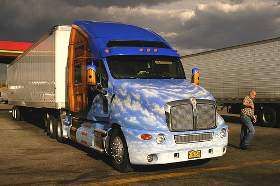Tips, Tricks, And Techniques For Rookie Drivers
Topic 16099 | Page 13
Thanks G-Town. Great stuff!

I used to live on the ridge top of a mountain a mile high in elevation and some of the tricks we used when things would freeze over, which it did often in winter. Keep a pray bottle with 3 parts vinegar/ 1 part water in it, spray outside of windshield and windows and it will keep then from getting a layer of ice on them overnight. Wipe windshield wiper blades with alcohol wipes, it will keep them from sticking to the window. Keep a small bottle of hand sanitizer in a spray bottle. If door and locks freeze spray sanitizer in it to unfreeze. Keep a small bag of kitty litter, if stuck on ice throw some under the tires to give traction to get rolling. It will save you from having to ruin your car mats. Spray Cooking Spray along the rubber and the cracks of your doors to keep them from freezing shut overnight. Rub headlights with toothpaste and rinse with warm water, keeps headlights clear in cold weather. Rub in car wax after to keep snow and ice from sticking to the lights.
Bumping this for all our new drivers.
I stopped north of KC this morning for a bathroom break and another driver came up to me on my way in and asked if I could help him understand how to make his load legal. His weights were roughly 12,800 on steers, 32,000 on drives and 30,000 on tandems. I explained he needed to slide the fifth wheel and he kept thinking I was talking about the tandems. Unfortunately I didnt have time to help him get it legal but I told him he'd need to find out what his steer tires and axle are rated for as well as what states he's travelling through allow. Ideally it'll be around 12k though so slide it back about 3 notches and reweigh. It may in some circumstances require you to slide your tandems due to the weight shifted backward. He seemed amazed that you can slide the 5th wheel (most companies have adjustable 5th wheel). I told him to check out YouTube (how I learned). It was pouring rain out and a little chilly. Definitely not the type of whether you want to be figuring something like this out.
I can't recall (I didn't re-read this entire thread either) there being a checklist for the trainees to make sure they're being taught the little things to make our jobs easier and safer. Unfortunately most training is such a short time and so many things can happen that it's hard to cover everything. It doesn't help either that so many trainers are in it for the wrong reasons and don't take the time you fully train the new driver. A student doesn't know what they've not experienced yet. If we could make a checklist of some sort it may help our new drivers be sure they're getting the most out of their training.
Tandems:
Tandem Axles
A set of axles spaced close together, legally defined as more than 40 and less than 96 inches apart by the USDOT. Drivers tend to refer to the tandem axles on their trailer as just "tandems". You might hear a driver say, "I'm 400 pounds overweight on my tandems", referring to his trailer tandems, not his tractor tandems. Tractor tandems are generally just referred to as "drives" which is short for "drive axles".
Tandem:
Tandem Axles
A set of axles spaced close together, legally defined as more than 40 and less than 96 inches apart by the USDOT. Drivers tend to refer to the tandem axles on their trailer as just "tandems". You might hear a driver say, "I'm 400 pounds overweight on my tandems", referring to his trailer tandems, not his tractor tandems. Tractor tandems are generally just referred to as "drives" which is short for "drive axles".
Listen to your gut not GPS!!!!! I got into some crazy situations from my early rookie days and I have 3 GPS going. Took a little time to learn the country and now I have a good idea where I’m going without them but had I listen to my gut in the beginning I wouldn’t need as much experience. At least 3 times a day I look at them and say you’re all crazy I’m not doing that. If it doesn’t feel right don’t do it!!!!
Keep a can of pb blaster. It comes in Handy for a lot of things
I coat my windshield with rainx once a week. Works well, and can get you by if you have a windshield wiper emergency.
If you have a trailer with a liftgate and the lift gate will go up and down but won’t come out, push it all the way down to the ground until it slightly puts weight on the trailer, then try again. Sometimes this will help the gears catch If the liftgate is stuck out. angle it down and back up ever so slowly so it slightly drags and generally this will get it back in Spare wood or leveling blocks to level out the trailer. , I was fighting freight at a store and was telling another driver about it and he told me that certain store had a specific rock laying around to chunk under the tandems 🤷🏻♂️. a.ALWAYS verify and then reverify your route!!!!!!!!!!!!! b. In case you forget this and start driving in a sketchy area , remember the last wide spot you saw 😂
Tandems:
Tandem Axles
A set of axles spaced close together, legally defined as more than 40 and less than 96 inches apart by the USDOT. Drivers tend to refer to the tandem axles on their trailer as just "tandems". You might hear a driver say, "I'm 400 pounds overweight on my tandems", referring to his trailer tandems, not his tractor tandems. Tractor tandems are generally just referred to as "drives" which is short for "drive axles".
Tandem:
Tandem Axles
A set of axles spaced close together, legally defined as more than 40 and less than 96 inches apart by the USDOT. Drivers tend to refer to the tandem axles on their trailer as just "tandems". You might hear a driver say, "I'm 400 pounds overweight on my tandems", referring to his trailer tandems, not his tractor tandems. Tractor tandems are generally just referred to as "drives" which is short for "drive axles".

Bump time for these great tips for all the new peeps, amazing what I find lurking for hours and weeks....
Bumping this excellent read!
New Reply:
New! Check out our help videos for a better understanding of our forum features

















Preview:
This topic has the following tags:
Advice For New Truck Drivers First Solo Months On The Road Items To Bring On The Road Life On The Road Truck Equipment








 TT On Facebook
TT On Facebook
“Hooking”, “coupling” definitely an area that requires careful attention. Trailers set too high, cranked too high can either cause a “high-hook” coupling or overriding the kingpin. I have always G.O.A.L.’d before getting completely under any trailer. Here is why...
As follows; yesterday morning an image of a trailer set too high that will likely cause a high-hook to occur, invariably resulting with dropping a loaded trailer. This is how it looked:
Notice the space between the lower edge of the trailer and the fifth wheel plate. No way it will positively couple. It required lowering the trailer so the edge is just touching the center pivot of the fifth wheel.
Here is the same angle after lowering the trailer a couple of inches.
This entire process required no more than 5 minutes, but likely saved 10x that time and a preventable in the event of a dropped trailer. G.O.A.L.’ing isn’t just for backing or close-quarter maneuvering. Performing this check before getting completely under a trailer part of my routine, I never skip it.